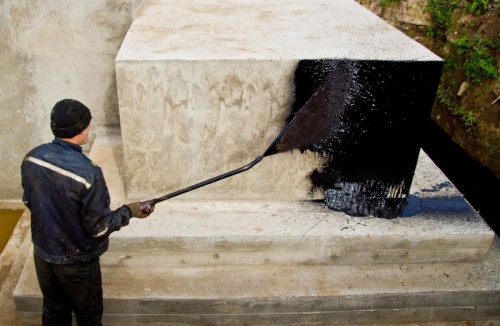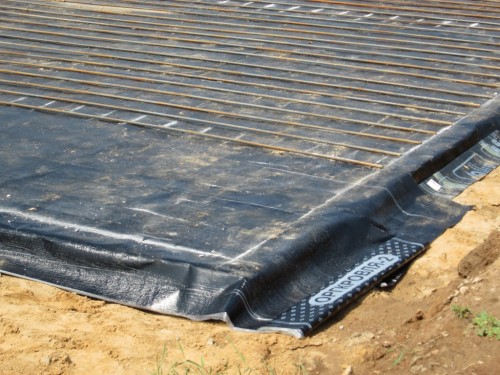The foundation, despite all its monolith, has a number of vulnerable places that you definitely need to know. Given that there are regions with different climatic zones in Russia, it should be borne in mind that in each case there are their factors that negatively affect the state of the foundation.
Content
Without additional measures associated with isolation, the foundation simply will begin to collapse. Moreover, it will begin to occur not a few years after the construction of the structure, but for several months. Foundation under threat of destruction is the worst for any construction. In this case, nothing will help, except for decisive measures.
If you speak directly about isolation, in most cases it is implied to protect the base of the house from moisture and water. The arrangement of waterproofing is a very serious process that has a lot of factors to pay attention to. Ultimately, if all the work is carried out correctly, the foundation will be in excellent condition for long years.
Main features of waterproofing
The most serious about the quality of waterproofing should be treated by those owners who have the ground floor in their private house. Accordingly, it is necessary to ensure the most optimal conditions, allowing the use of space under the main rooms at home with comfort. It should be borne in mind that even the most common precipitates are able to leak through the foundation and get into the dwelling.
In addition, you should not forget about soil waters. If the foundation is significantly deepened in the ground, the probability of moisture getting into the basement is quite high. In such a situation, if moisture and water immediately after the construction begin to fall into the dwelling, you should immediately do with insulating events.
Of course, these actions need to be conceived during the construction of the house. In the preparation of a construction project, all the features that land must be taken into account. First of all, we are talking about the negative impact of soil waters. However, it is often obtained that the soil movements themselves are extremely negatively affecting the foundation-related situations. Accordingly, it is often quite difficult to foresee exactly how the water will affect the base.
Many specialists argue that first of all should be paid attention to the location of the groundwater. And the most interesting thing is that at any moment the situation can change significantly, and this, for example, can lead to a complete flooding of the foundation. The location of the waters can affect the construction site, located near the house, laying the road, the installation of massive objects on the soil.
Also, attention should be paid to the following factors:
- Powered water in the soil. It is necessary to know that the fluid in the soil can be under strong pressure, and this is a serious threat to the entire structure. In order not to get into the unpleasant situation, which can lead to the most terrible consequences, a geodesic analysis of the soil should be carried out. In this case, you can install all the necessary information and already be prepared for any surprises. This is especially important in cases where the house is built in places remote from the main residential areas.
- In addition, if we choose the waterproofing, to begin with the characteristics of the soil. Separate types of soils are extremely negatively affected by the foundation. The thing is that waterproof soils can bring water straight to the foundation. With this scenario, the waterproofing layer should be simply flawless.
- Again, much depends on the type of foundation. It is from the characteristics of the base should be repeated when the insulating material is selected.
Swampy terrain and waterproofing foundation
Most often at home are built on neutral soils that do not have virtually no significant drawbacks. However, sometimes one or another territory attracts people who decide to build houses in fairly difficult conditions. The swampy terrain is those conditions that need to be avoided, despite the fact that an externally land plot can simply be fantastic.
If the construction still took place, then it is necessary to know that the foundation can be used to spend gravity money. In addition, you do not need to forget about the drainage system, which will successfully remove water from the structure. This is necessary to take care even at the construction stage of the building.
In addition, before the construction of the foundation, you should think about the main options for the protection of the future house from the negative action of water. It is necessary to think about the pit of the structure. The bottom should also be protected from the negative impact of moisture and water. It is necessary to create an insulating layer, which will consist of gravel, coarse sand and layer of concrete. Next, after the concrete gained the necessary strength, it is possible to apply a water-repellent composition. Only after that we can safely apply mastic on the surface of the foundation, and the waterproofing material is stacked on top.
Separately, it is worth noting the peculiarities of the boronabivinal foundation, to which the waterproofing of which should be treated especially seriously. In this case, a formwork is created, which consists of pipes. These same pipes must be treated with protective compositions. It should be especially serious about sealing the bottom of the pipes. Concrete composition itself affects the state of the foundation. If he is really high-quality, then the foundation will serve for a long time even in no most favorable conditions. Wells, which are made to build a burbill foundation, must be covered with clay, sand, as well as gravel. This will again significantly increase the characteristics of the base, including waterproofing.
Ribbon foundation
In conditions when the construction of a small house occurs, the tape type of foundation is most often used. It should be paid to the fact that in this case we have a basement, which unambiguously needs to be protected from the effect of water and moisture. At a minimum, take care of the use of protective compositions. Of course, they will not provide an excellent result, but some effect will still demonstrate. First of all, you need to take care of the isolation of the external walls of the structure, since in this case we can have the strongest pressure of groundwater. If we use referenced or film for waterproofing purposes, then you need to lay material in several layers. Obviously, in this situation the most important thing is not the thickness of the layer, but the quality of laying isolation. Accordingly, it is necessary to do everything possible so that the moisture does not accidentally enter the insulating material and did not destroy it. It will not be easy to do so, as the runneroid, first of all, is produced for mounting on horizontal surfaces.
The film is an inexpensive version that allows you to forget about the action of moisture, but it is necessary to know that this material is very easy to damage. Film, which is often available in construction stores, small thickness. As the main material used to protect against water, the film is better not to choose.
Any waterproofing material should be placed in the interface, since in case of manifestation of any damage, the products will continue to perform their work without significant problems.
In addition, the external walls located under the soil can be simply placed. Often, no additional measures necessary to protect the foundation from moisture are no longer needed.
The inner walls also need to be protected from water exposure. First of all, you need to take care of the isolation of places that are located around the means of communication. It may be, for example, pipes that pass through the foundation design. In such places, moisture and water appear in the first place. Most often, liquid glass or mastic should be used for waterproofing such places. You can carry out small experiments to make sure in the effectiveness of sealing. If everything is fine, then you can proceed to the sealing of the walls.
Using penetrating waterproofing
Experts argue that for complete waterproofing, which protects against the constant action of moisture, is best to use penetrating agents. Before working connected with isolation, it is necessary to analyze groundwater occurrence in order to approach the main stage of work as responsibly.
Often penetrating waterproofing is sold in large bags in the form of dry powder. Accordingly, the mixture is created before treating surfaces, which is based on a dry component and water. Next, you can safely take the brush (or roller) and apply the waterproofing composition directly on the walls of the foundation. With high-quality applied, the mixture crystals quickly displaces water in the pores of concrete. Ultimately, the surface becomes impregnable for water, and even more so for moisture.
According to the manufacturers of penetrating waterproofing themselves, such mixtures penetrate inside concrete on tens of millimeters, therefore the foundation is in complete safety, regardless of the volume of water present around the structure. At the same time, of course, if the water is too much, then the concrete base itself can begin gradually collapse, therefore, as already mentioned, it is better to use the drainage system.
And the advantages of penetrating waterproofing are as follows:
- Easy use. In order to cover the foundation of waterproofing, you must have a minimum of tools. Experience is not needed at all.
- Versatility. This waterproofing can also be used to process underground parts of the foundation, and overhead. Moreover, most manufacturers produce mixtures that can be applied to fresh foundations, and on the old concrete construction. There are also no restrictions and in terms of processing the outdoor and inner walls of the foundation.
- High-quality permeability. After applying the mixture to the surface, it becomes with concrete in one whole, so it will not be possible to damage or remove the waterproofing layer.
If we talk about the technology of application of penetrating waterproofing, it consists of several simple steps:
- At the very beginning, it is necessary to clean the surface of the foundation to open all the capillaries for the unhindered penetration of the waterproofing composition. If there is a mold on the surface, you need to process everything with an antiseptic.
- Next you need to moisten the concrete. The effectiveness of waterproofing depends on this.
- Well, ultimately applying a mixture with a brush, roller or brushes.
Rolled waterproofing foundation
This type of waterproofing is used if the groundwater is at a sufficiently high level, so there is a need for reliable and really effective protection against water.
Fortunately, the application of these materials on the surface is quite simple. It is only necessary to dry the surface of the foundation throughout the perimeter of the structure and trace so that no gaps attended the material between the strips. It is in the premises that are present and the most serious problem of rolled waterproofing is hidden.
Modern polymer-bitumen materials really effectively demonstrate themselves during waterproofing of large buildings, even if groundwater directly affect the structure.
Cement waterproofing
This option is most often used in small buildings, which affects a small amount of moisture. Under the cement waterproofing means the use of a cement composition with hydrophobic components. Accordingly, in such circumstances it is necessary to create a sufficiently thin layer of cement on the foundation surface, so that it effectively protects the construction from the negative influence of moisture.
Of course, to the effectiveness of the roll and penetrating waterproofing cement variant very far.























